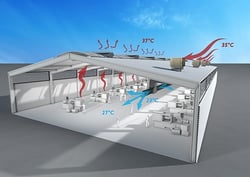 I received some excellent questions during my recent webinar on evaporative cooling. Here you can see my answers to these questions, slightly edited for clarity.
I received some excellent questions during my recent webinar on evaporative cooling. Here you can see my answers to these questions, slightly edited for clarity.
There is also a recording of the webinar available.
Is there an issue with water freezing during the winter?
During the winter season the CoolStream wouldn't normally require water as the external ambient temperature are sufficiently low. As no water is needed during this time, the unit is drained down so there is no risk of freezing. The construction materials are designed for use externally so there are no issues with the very cold freezing conditions.
Question about why you can’t use the system in humid countries
If we remember the psychometric charts we looked at, the requirement is that the air has some capacity to absorb moisture. So in very, very humid countries where the external ambient conditions have humidities of 80 or 90%, there generally isn’t sufficient capacity to allow the water to evaporate and so the air to reduce in temperature, so it’s just a physical constraint really. Almost all parts of the UK are perfectly fine for evaporative cooling, but if you want to check a specific area then contact us on climate@uk.coltgroup.com.
What maintenance is required for an evaporative cooling system?
The units have an annual service in order to inspect, clean and check filters / desorption media. We recommend this service is done before the start of summer. There is also a winter change over to disconnect the water and set the unit to fan only. This can be done remotely if required.
In terms of the materials within the unit, it’s largely dependent upon the outside air quality, but we normally say that they should be replaced every 3 years or so. This could increase however, due to filtration becoming the norm. The condition of the filter is automatically monitored and a pre-warning sent to the operator to make them aware of the need for replacement before it becomes an issue.
How is the water changed to avoid it becoming stagnant?
The control system is constantly checking the operation of the unit. It has staged watered refreshment routines that it goes through and the water is constantly being pumped around the cooler when it’s in evaporation mode. Where outside conditions are providing a temperature where evaporative cooling isn’t necessary, the unit is drained and dried automatically so there is no real opportunity for stagnant water to actually occur.
Is sea water suitable for evaporative coolers?
Not really, no. Nor is water that is recovered from tanks or run-off type systems. We would always recommend that fresh water is used.
What guidlines are there for humidity levels in data centres?
The ASHRAE Guidelines dictate what the acceptable range of temperatures and humidites are. This is why the control system is important to monitor the levels - it is not as simple as just putting an evaporative cooler onto a data centre. The range is between 20 – 80% humidty, so for an effective Data Centre system the evaporative cooler has to have some ability to control the humidity both up and down by either re-circulating air or introducing more fresh air. A simple unit won’t be able to achieve some of that control at the outer edges of the ASHRAE Guideline.
Contact us
If you have a specific project in mind then please email us on climate@uk.coltgroup.com and we will get one of our engineers to contact you and see what your needs are and what is the best approach.
 Paul Langford is an Engineering Director experienced in product development, manufacturing & testing for HVAC, louvre and smoke control systems.
Paul Langford is an Engineering Director experienced in product development, manufacturing & testing for HVAC, louvre and smoke control systems.


